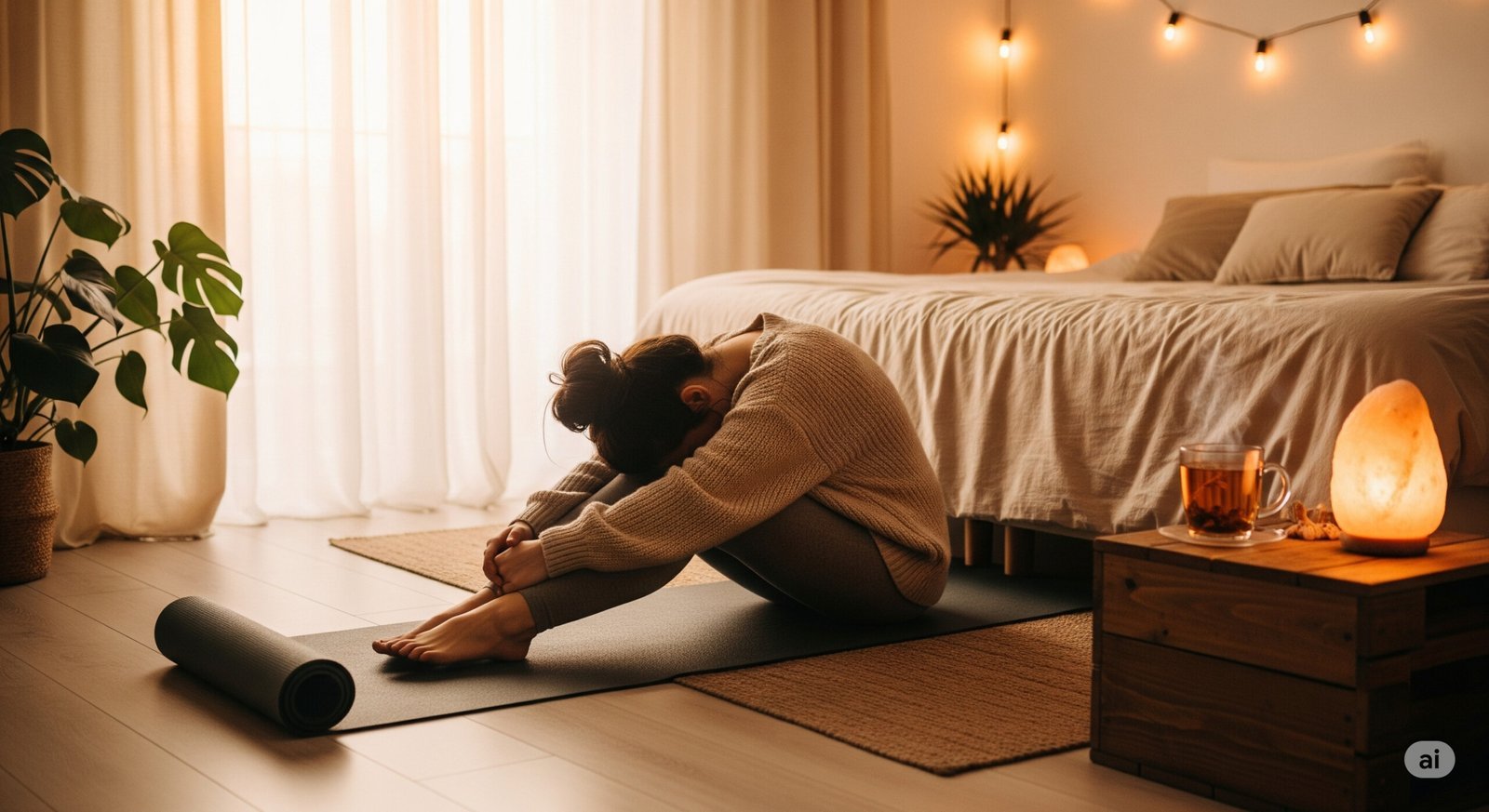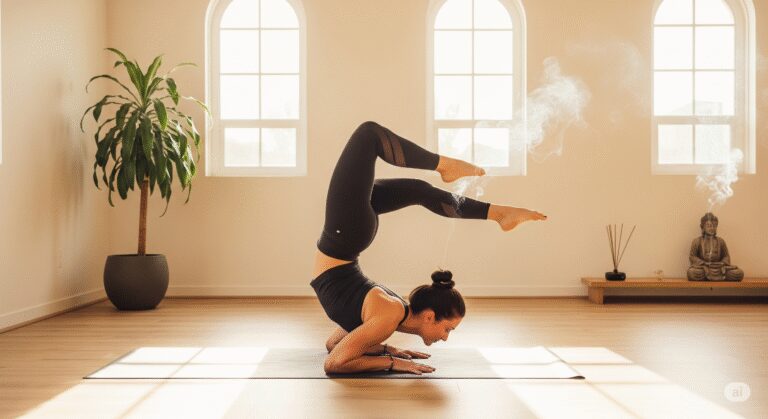8 Calming Bedtime Yoga Poses That Promote Deep Sleep
It was one of those nights again. The clock glowed 1:17 AM, the ceiling fan hummed its soft tune, and yet sleep felt like a distant friend who refused to visit. I tossed, turned, and sighed, trying every trick I knew—counting backwards from 100, sipping chamomile tea, even adjusting my pillow just right. But nothing seemed to quiet my racing thoughts.
Thank you for reading this post, don't forget to subscribe!Then one evening, a friend suggested something so simple it almost sounded too good to be true: “Why don’t you try a few bedtime yoga poses? Not the sweaty, fast-paced kind—just slow, gentle stretches that help your body and mind wind down.”
That night, I gave it a try. I rolled out my yoga mat in my dimly lit bedroom, let a lavender candle flicker nearby, and moved through a series of gentle, calming stretches. The result? My breath slowed, my muscles softened, and for the first time in weeks, I drifted into the kind of deep, restful sleep I’d been craving.
If you’ve been longing for nights filled with peaceful slumber, you might be surprised at how bedtime yoga poses can help. These aren’t about building strength or breaking a sweat—they’re about slowing down, releasing tension, and signaling to your body that it’s safe to rest.


Why Bedtime Yoga Works Wonders for Sleep
Yoga is often associated with early mornings or energizing flows, but the truth is, it’s just as powerful before bed—if not more so. Gentle night yoga helps release physical tightness, calm the nervous system, and prepare your mind for rest.
When you engage in slow, mindful movement before sleep, a few magical things happen:
- Your body shifts from “fight or flight” to “rest and digest” thanks to the activation of the parasympathetic nervous system.
- Muscles relax after a long day of sitting, standing, or rushing around.
- Mind chatter slows, creating mental space for deep, uninterrupted sleep.
And unlike screen time, which can trick your brain into staying alert, relaxing stretches signal that the day is coming to a gentle close.
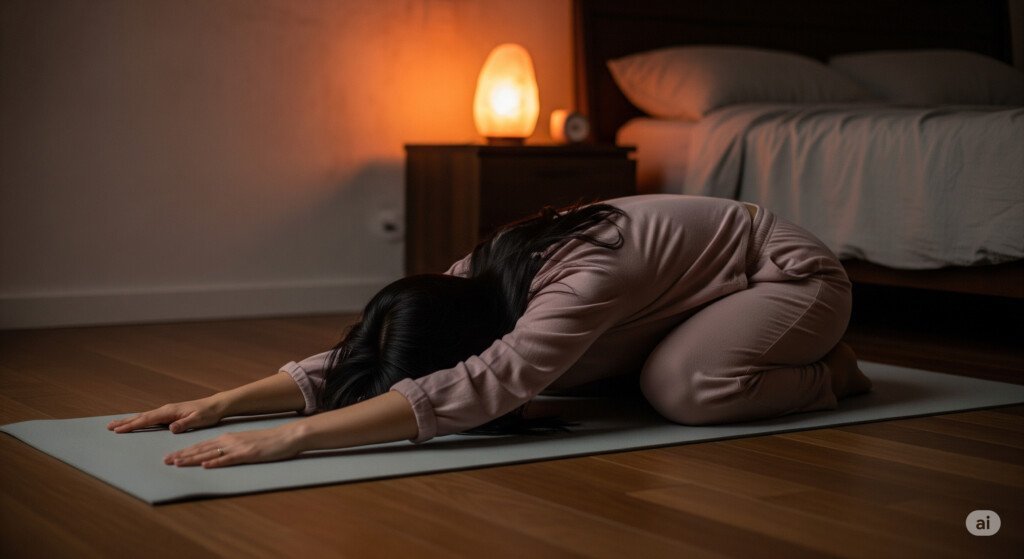

How to Set the Scene for Bedtime Yoga
Before diving into the poses, creating a relaxing environment is key. You don’t need an elaborate yoga studio—just a few tweaks to your surroundings can make all the difference.
Here’s how to turn your bedroom or living room into a mini nighttime yoga retreat:
- Dim the Lights – Swap bright overhead lights for soft lamps or candles.
- Add Soothing Scents – Lavender, chamomile, or sandalwood essential oils can set the mood.
- Play Gentle Music – Soft piano, nature sounds, or slow ambient tunes work well.
- Wear Cozy Clothing – Choose loose, breathable fabrics so your body feels at ease.
- Keep Your Mat Nearby – This makes it easier to stick with your nightly ritual.
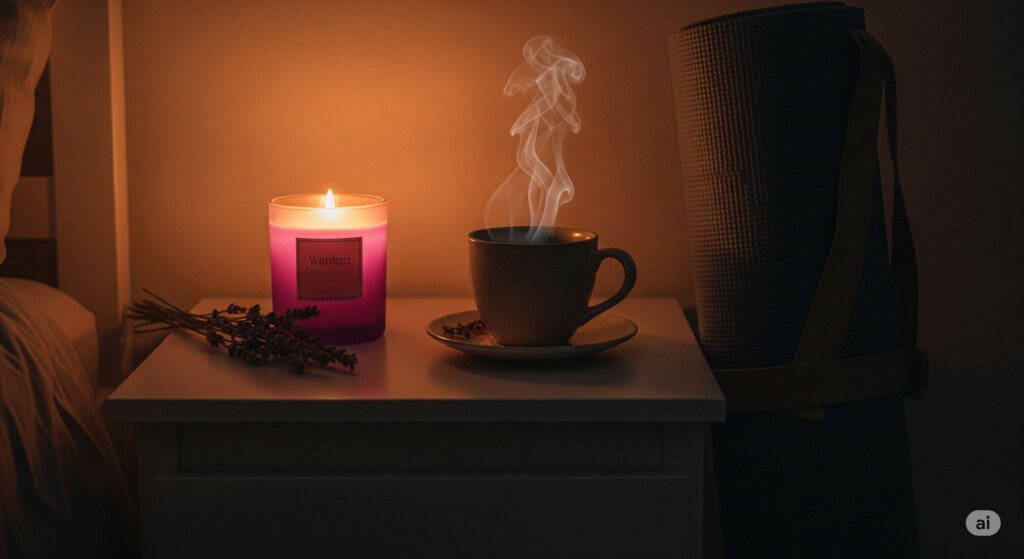

The 8 Calming Bedtime Yoga Poses for Deep Sleep
Below, I’ll share eight gentle, sleep-aid yoga poses that I’ve personally found effective. You can do them all or just choose a few based on how much time you have. The key is moving slowly and breathing deeply.
1. Child’s Pose (Balasana)
The ultimate unwind yoga posture for releasing tension.
Why it works: This simple forward-folding pose soothes the mind, stretches the back, and helps release the day’s worries. It’s grounding, comforting, and can be held for several minutes.
How to do it:
- Kneel on your mat with your big toes touching and knees apart.
- Fold forward, extending your arms in front of you or resting them alongside your body.
- Rest your forehead on the mat (or a pillow for extra comfort).
- Breathe deeply, letting your hips sink toward your heels.
Sensory tip: Imagine exhaling all the day’s stress into the mat beneath you.
Hold for: 1–3 minutes.
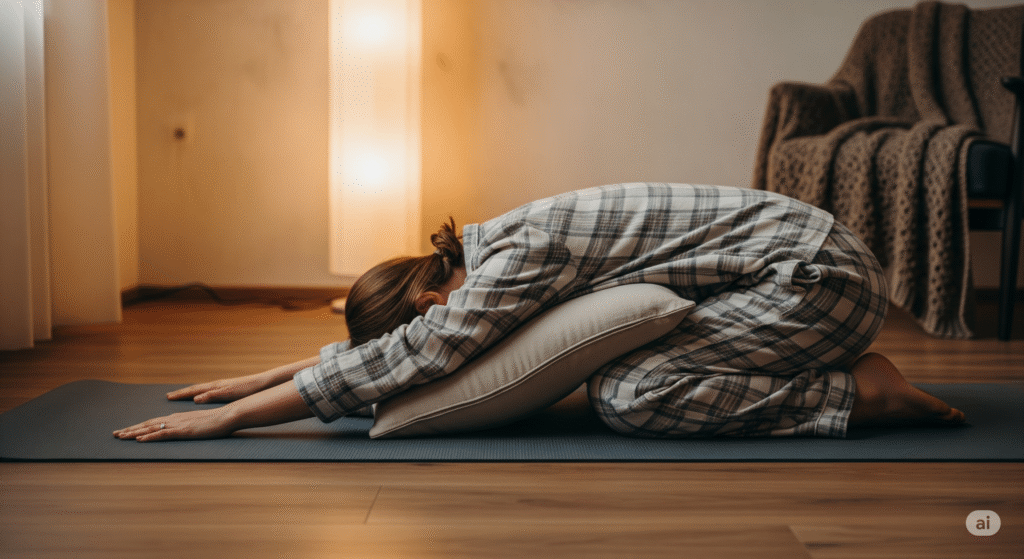

2. Supine Bound Angle Pose (Supta Baddha Konasana)
A heart-opening, hip-releasing pose perfect for bedtime.
Why it works: This pose gently stretches the inner thighs and opens the chest, which can help counteract slouching from sitting all day. It’s deeply restorative when paired with slow breathing.
How to do it:
- Lie on your back with your knees bent and feet on the floor.
- Let your knees fall open, bringing the soles of your feet together.
- Place pillows or yoga blocks under each knee for support.
- Rest your hands on your belly or by your sides.
Tip: If you want extra comfort, a bolster pillow can make this pose even more relaxing.
Hold for: 3–5 minutes while focusing on slow, steady inhales and exhales.


3. Legs Up the Wall (Viparita Karani)
A gentle inversion that helps drain tension from the legs and feet.
Why it works: This pose reduces swelling in the legs, calms the nervous system, and encourages circulation—perfect if you’ve been on your feet all day.
How to do it:
- Sit with one side of your body against a wall.
- Swing your legs up and lie back so your legs rest vertically against the wall.
- Keep your arms relaxed by your sides, palms facing up.
Sensory tip: Close your eyes and imagine a gentle waterfall of relaxation flowing from your toes down to your head.
Hold for: 5–10 minutes for maximum benefit.


4. Seated Forward Bend (Paschimottanasana)
A calming stretch for the spine and hamstrings that quiets the mind.
Why it works: This forward-folding posture helps release the back and shoulders while promoting introspection and calm.
How to do it:
- Sit with your legs extended in front of you.
- Inhale to lengthen your spine, then exhale to fold forward from the hips.
- Rest your hands wherever they reach—shins, ankles, or feet.
- Relax your head and neck.
Tip: If flexibility is a challenge, a yoga strap can help you ease into the stretch.
Hold for: 1–3 minutes, breathing deeply into your back body.


5. Reclined Spinal Twist (Supta Matsyendrasana)
A gentle twist to release lower back tension and encourage digestion before bed.
Why it works: Twists help wring out built-up tension from the spine and can improve digestion, which is useful if you’ve had a late dinner. This pose also creates a sense of release in the back and hips.
How to do it:
- Lie on your back with your knees bent and feet flat.
- Hug your knees into your chest.
- Drop both knees to one side, keeping your shoulders on the floor.
- Turn your head in the opposite direction for a full twist.
- Place a pillow between your knees if it feels more comfortable.
Sensory tip: Imagine wringing out all the stress from your day like twisting water out of a soft towel.
Hold for: 1–3 minutes on each side.
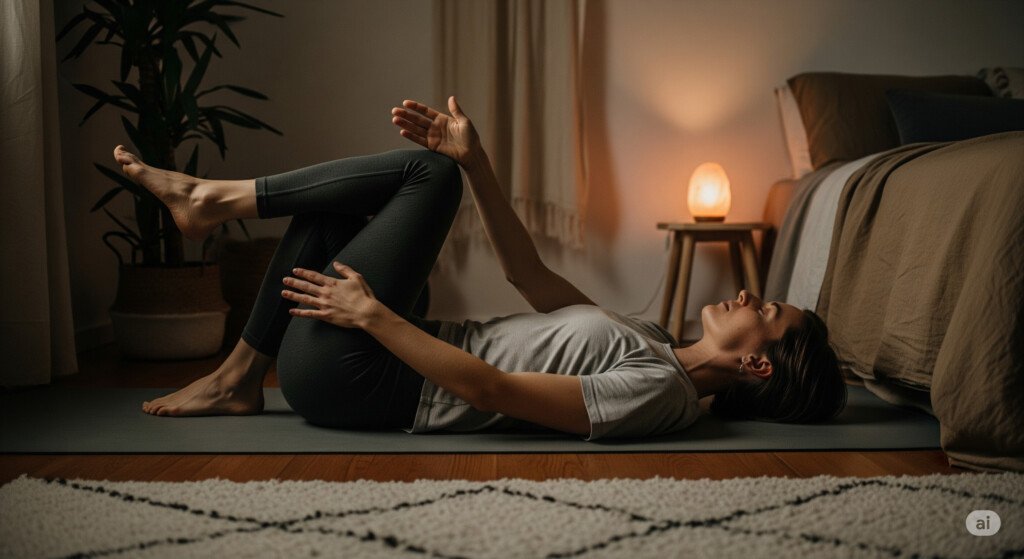

6. Cat-Cow Stretch (Marjaryasana–Bitilasana)
A flowing movement to release stiffness in the spine.
Why it works: Cat-Cow is both energizing and relaxing—it helps you release tension while bringing awareness to your breath. Doing it slowly before bed can be a moving meditation.
How to do it:
- Start on all fours with your wrists under shoulders and knees under hips.
- Inhale as you drop your belly, lift your chest, and gaze up (Cow Pose).
- Exhale as you round your spine, tuck your chin, and gaze toward your belly (Cat Pose).
- Move slowly, syncing each movement with your breath.
Tip: If your knees are sensitive, a thick yoga mat can make this flow more comfortable.
Duration: Repeat for 1–2 minutes at a slow, steady pace.
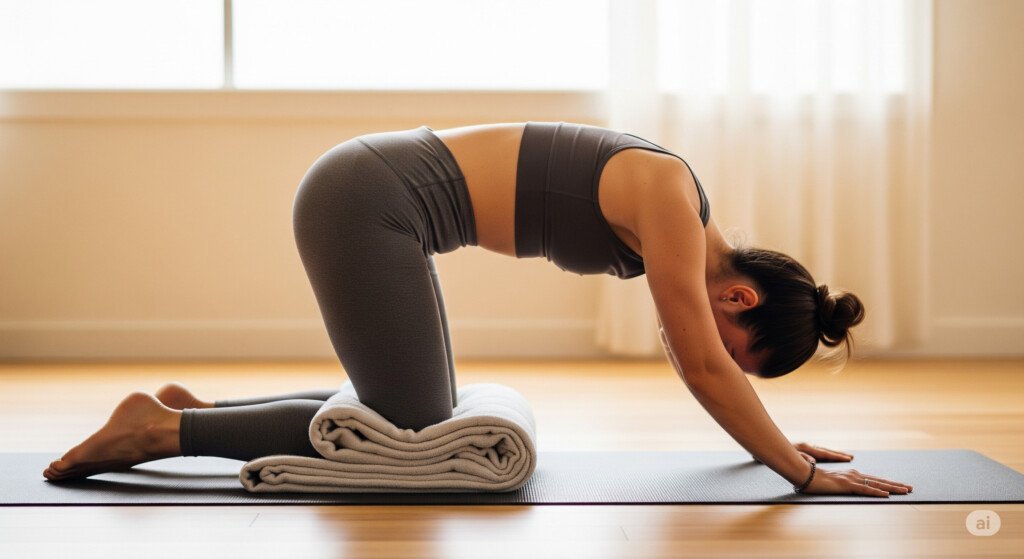

7. Supported Bridge Pose (Setu Bandhasana)
A gentle heart opener that relieves lower back tension.
Why it works: This pose creates space in the chest and shoulders while lightly stimulating the thyroid—helpful for balancing energy before bedtime. With support, it becomes fully restorative.
How to do it:
- Lie on your back with knees bent and feet hip-width apart.
- Lift your hips slightly and slide a yoga block or pillow under your lower back.
- Rest your arms by your sides.
- Close your eyes and breathe deeply.
Sensory tip: Picture your heart area filling with a soft, warm light, melting away any leftover anxiety.
Hold for: 2–4 minutes.
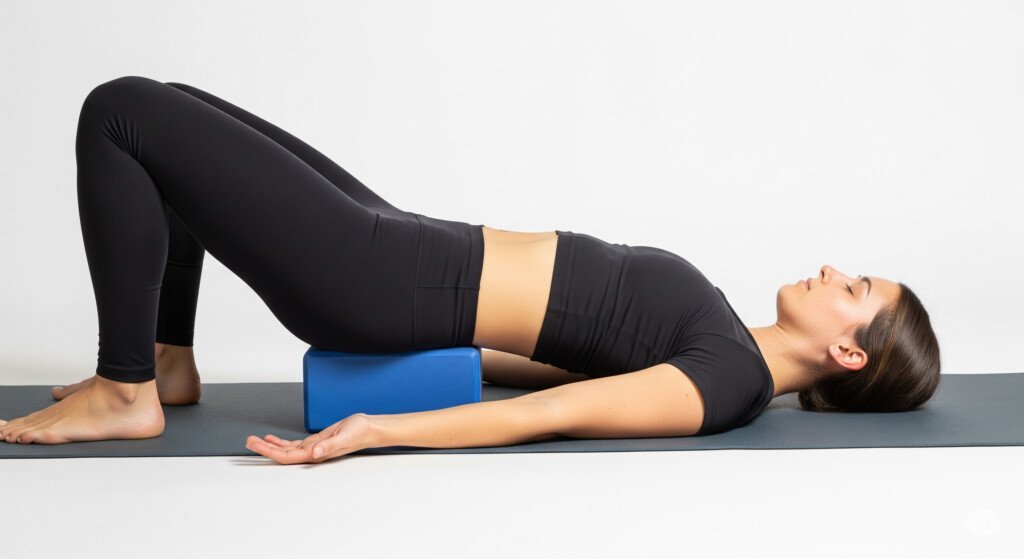

8. Corpse Pose (Savasana)
The final, ultimate relaxation pose before bed.
Why it works: Savasana helps integrate the benefits of your practice, allowing your body and mind to fully let go. It’s the bridge between movement and restful sleep.
How to do it:
- Lie flat on your back with legs comfortably apart and arms by your sides.
- Close your eyes and let your whole body sink into the floor.
- Focus on your breath, or do a gentle body scan from head to toe.
Tip: A weighted blanket can add a cocooning effect, making this pose extra soothing.
Duration: 5–10 minutes, or until you feel completely relaxed.
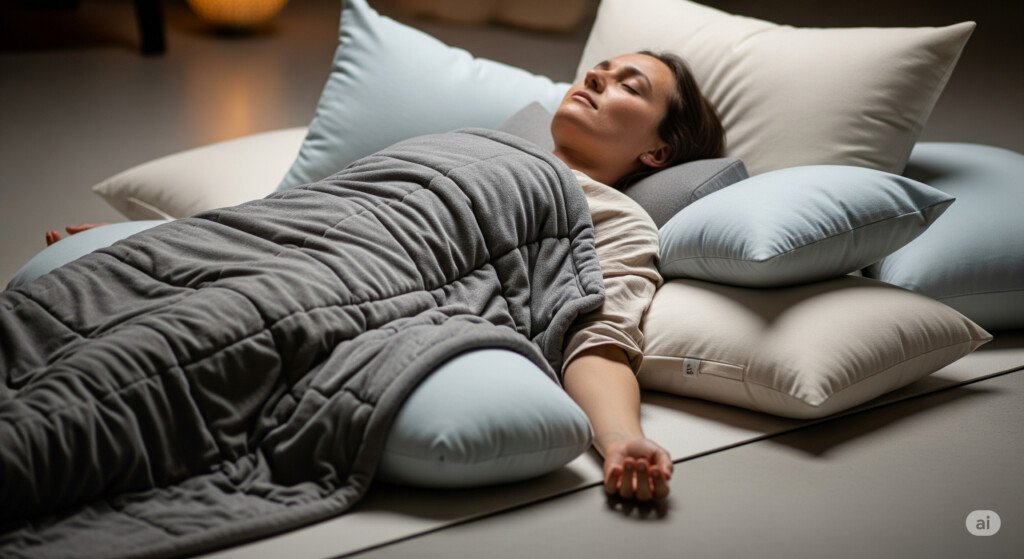

How to Turn This Into a Bedtime Ritual
While you can practice these poses anytime you need to unwind, turning them into a consistent nighttime routine amplifies their benefits.
Here’s a sample 15-minute bedtime yoga flow:
- Child’s Pose – 2 minutes
- Supine Bound Angle Pose – 3 minutes
- Legs Up the Wall – 4 minutes
- Reclined Spinal Twist – 2 minutes (1 minute each side)
- Savasana – 4 minutes
💡 Tip: Pair your practice with a calming playlist and soft lighting for a spa-like feel.


Additional Sleep-Friendly Practices to Pair with Bedtime Yoga
To maximize the benefits of your unwind yoga practice, you can combine it with a few simple habits:
- No screens for 30–60 minutes before bed – Avoid blue light exposure to help your brain naturally release melatonin.
- Keep your bedroom cool – Around 65°F (18°C) is ideal for sleep.
- Write down your thoughts – A quick journaling session can clear mental clutter.
- Sip a sleep-friendly drink – Herbal tea blends like chamomile or valerian root can help.
- Practice gratitude – Ending your day with positive reflection sets a peaceful tone.


Conclusion: Your Path to Deep, Restful Nights
When I first tried bedtime yoga, I wasn’t sure if something so simple could actually help me sleep better. But after just a few nights, I noticed the difference—not just in how quickly I fell asleep, but in how deeply I stayed asleep.
These bedtime yoga poses aren’t about perfect form or flexibility—they’re about giving your body and mind permission to rest. By creating a calming nightly ritual, you’re sending a clear signal to your brain: “It’s safe to let go now.”
So tonight, instead of scrolling through your phone or watching one more episode, roll out your mat, dim the lights, and let yourself melt into these gentle, restorative shapes. Your future, well-rested self will thank you. Need to know more about best yoga poses!
FAQ
1. Can I do bedtime yoga if I’m not flexible?
Absolutely! These poses are gentle and can be modified with pillows, bolsters, or straps. Flexibility is not a requirement—comfort is.
2. How long before bed should I practice?
Ideally, 20–30 minutes before you plan to sleep. This gives your body time to transition from movement to rest.
3. Can bedtime yoga replace meditation?
It can complement meditation. In fact, the mindful breathing in yoga acts as a moving meditation, making it easier to relax.
4. Is it okay to fall asleep during Savasana?
Yes! In a bedtime practice, drifting off in Savasana is perfectly fine—it means your body is fully letting go.
5. What if I wake up in the middle of the night?
You can try a few of the gentler poses, like Child’s Pose or Supine Bound Angle, right in bed to help you fall back asleep.
Disclaimer:
This post may contain affiliate links. If you purchase through them, we may earn a small commission at no extra cost to you. Also, this content is for informational purposes only and does not substitute professional medical advice.

